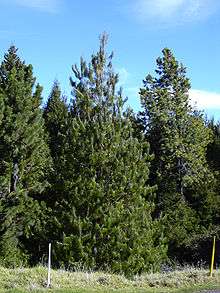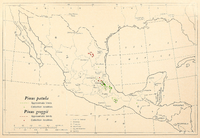Pinus patula
| Patula pine | |
|---|---|
 | |
| Scientific classification | |
| Kingdom: | Plantae |
| Division: | Pinophyta |
| Class: | Pinopsida |
| Order: | Pinales |
| Family: | Pinaceae |
| Genus: | Pinus |
| Subgenus: | Pinus |
| Species: | P. patula |
| Binomial name | |
| Pinus patula Schiede ex Schltdl. & Cham. | |
 | |
| Natural range of Pinus patula | |
Pinus patula, commonly known as patula pine, spreading-leaved pine, or Mexican weeping pine, and in Spanish as pino patula or pino llorón, (patula Latin = spreading) is a tree native to the highlands of Mexico. It grows from 24° to 18° North latitude and 1800 to 2700 m above sea level. The tree is 30 meters tall. It cannot not stand long periods of temperatures as low as –10 °C, but resists occasional brief below zero dips. It is moderately drought-tolerant, in this respect it is superior to Pinus taeda. Rainfall range is from 750 to 2000 mm annual average, it happens mostly in summer but in a little area of the State of Veracruz on the Sierra Madre Oriental its habitat is rainy year round.
It is planted at high altitudes in Ecuador (3500 m), Bolivia, Colombia (3300m), Kenya, Tanzania, Angola, Zimbabwe, Papua New Guinea, and Hawaii (3000 m). In Hawaii it is replacing the native alpine grassland.
At lower altitudes than its origin country it is cultivated in Southern Brazil, South Africa, India, and in the Argentine provinces of Córdoba and San Luis.[1] it is planted for forestation purposes in lands originally covered by bushland.
It has been introduced near sea level in New South Wales, Australia, where it spreads naturally by wind and is very favored because rainfalls are more abundant in summer. It was also introduced in New Zealand for commercial purposes and is fully naturalized there. It is cultivated in the United Kingdom as an ornamental tree for parks and gardens, and has gained the Royal Horticultural Society's Award of Garden Merit.[2]
The timber is pale-pink to salmon, moderately soft, brittle and smelling strongly of aniseed when freshly cut.
Taxonomic notes
There are two varieties:
1. P. patula Schiede ex Schlechtendal et Chamisso var. patula. Type Mexico, Veracruz: Cruz Blanca, "Inter Cruz blanca & Jalacingo," 1828.11, Schiede and Deppe 1108 (lectotype, HAL). Syn.: Pinus patula Schiede ex Schlechtendal et Chamisso var. macrocarpa M.T. Masters, Gard. Chron., ser. 3, 9: 438, fig. 92. 1891. Type. Gard. Chron., ser. 3, 9: 435, fig. 92. 189 1. (lectotype) (Farjon and Styles 1997).
2. P. patula Schiede ex Schlechtendal et Chamisso var. longipedunculata Loock ex Martínez, Pinos Mexicanos, ed. 2, 333, figs. 276-280, 1948. Type Mexico, Oaxaca: Rancho Benito Juárez (Rancho Tablas), 1947.07, Loock 113a (holotype, PRF-n.v.; isotype, MEXU) (Farjon and Styles 1997).
Farjon and Styles (1997) provide the following notes on the history of the species and its varieties: "Schlechtendal and Chamisso (1831) gave under C.J.W. Schiede & F. Deppe 1108 a concise description of a 3-leaved pine, of which they had seen no cones ('strobilo . . . nobis deficiente') in the material presented to them. ... Gordon (1875) described Pinus patula (var.) macrocarpa based on collections by C.J.W. Schiede with a cone size 'from 6-7 inches long and 2 inches broad', which, if correct, would be quite outside the range of this species as here defined. Masters (1891) formally published this combination and provided an illustration of the cone. No specimen has been traced in the herbaria to match the descriptions and/or the illustration. The illustration in Masters (1891) is therefore designated as the lectotype. ... Martínez (1948) ascribed his new variety P. patula var. longipedunculata to Loock, who coined the name on the label of the type specimen. He described it as different from 'typical’ P. patula in having 2 resin ducts in the leaves instead of 3 and in having pedunculate (5–15 mm) cones versus sessile cones. Perry (1991) allows it occasionally 3 resin ducts."
Farjon and Styles (1997) also report that "Styles (1976) concluded that 'it agrees phenotypically in all botanical characters' with those mentioned by Martinez (1940) under P. oocarpa var. ochoterenae and synonymized both under P. patula. He later expressed a different view (Styles, 1984) but stopped short of formally synonymizing these two taxa under his newly created combination P. patula subsp. tecunumanii. From his determinations of specimens it appears that P. oocarpa var. ochoterenae Martínez was treated as a synonym of P. patula subsp. tecunumanii (see under P. tecunumanii), but that at least more-recently collected material (Higman, Padilla & Styles 40) was again accepted as P. patula (subsp.) longipedunculata. Observation in the field and study of type material by A. Farjon confirm recognition of this taxon as a variety if peduncle length is coupled with persistence and serotiny, which may point to different adaptive traits between the two taxa." Note that Furman et al. (1997) have used RAPD markers to show clear and substantial genetic differences between P. patula and P. tecunumanii, establishing the latter as a good species.

Closely related species include Pinus greggii, P. jaliscana, P. oocarpa, P. praetermissa, P. pringlei, and P. tecunumanii, all of which also are native to Mexico.
Description
The tree grows to 40 m tall and 100 cm dbh, usually with a single, straight, slender trunk; in closed canopy stands, the depth of the conical or domed crown is ca. 33%.
The Bark on young trees is thin, scaly, red-brown, with age becoming thick, dark grey-brown, rough and scaly with large elongated plates and deep longitudinal fissures. First-order branches are long, slender, spreading or slightly ascending; higher order branches are slender, drooping, the ultimate branches pendent. The shoots are rough and scaly when the leaf fascicles have fallen, yellow- to red-brown, foliage shoots with prominent, decurrent pulvini. Cataphylls subulate, recurved at apex, scarious, with erose-ciliate margins, brown, early deciduous. Vegetative buds oblong to cylindrical, the terminal bud 15–20 mm long, the laterals shorter, brown, not resinous; the scales spreading, subulate, ciliate at margins. Fascicle sheaths initially 20–30 mm long with 6-8 imbricate, chartaceous, white-yellow to orange-brown scales, persistent but shortening to 12–15 mm in mature fascicles, slowly weathering to grey-brown.
Leaves in fascicles of 3-4(-5), in drooping tufts, typically in two rows on either side of the upturned shoot, persisting 2–3 years, thin, lax, drooping to pendent, (11-)15-25(-30) cm × 0.7-0.9(-1) mm, serrulate at the margins, acute, pale green to dark green. Stomata on all faces of the leaves, in 4-6(-7) lines on the convex abaxial face and 2-3(4) lines on each adaxial face. The leaves are triangular in cross section, the hypodermis usually with a double layer of cells; resin ducts (1-)2-3(4), medial, occasionally 1 internal, stele oval in cross section; outer walls of endodermal cells not thickened; vascular bundles 2, distinct, the xylem strands often connate.
Pollen cones crowded near the proximal end of new shoots, spreading, subtended by scarious bracts, ovoid-oblong to cylindrical, 15-20 × 5–6 mm, pink-yellow, turning yellow-brown. Seed cones subterminal or lateral, in whorls of 2 to many, rarely solitary, persistent or deciduous, on short or moderately long (to 20 mm) peduncles. Immature cones ovoid, on short or long recurved peduncles with persistent cataphylls, purple turning light brown, maturing in two seasons. Mature cones narrowly ovoid when closed, usually slightly curved, more or less asymmetrical at base, 5-10(-12) × (3-)4-6.5 cm when open.
Seed scales 100-150, serotinous or parting some time after maturing, tenacious or deciduous with the peduncle, (thin) woody, oblong, usually curved when spreading, the proximal scales connate, purple-brown to dark brown, with adaxial light brown marks left by seed wings. Apophysis nearly flat to slightly raised, transversely keeled, more or less gibbous on the proximal scales, more so on one side of the cone, rhombic, upper margin acute or obtuse-rounded, abaxial surface striate or smooth, (lustrous) ochraceous or yellow-brown. Umbo dorsal, flat or raised, often sunken into the apophysis, 3–7 mm wide, grey, with a minute, deciduous prickle. Seeds obliquely ovoid, flattened, 4-6 × 2–4 mm, dark gray. Seed wings articulate, held to the seed by two oblique claws which partly cover the seed on one side, obliquely ovate-oblong, 12-18 × 5–8 mm, light brown with dark stripes (Farjon and Styles 1997).
References
- ↑ "Mexican conifers in San Luis Province, Argentina".
- ↑ "RHS Plant Selector - Pinus patula". Retrieved 30 June 2013.
- Eguiluz T.1982. Clima y Distribución del género pinus en México. Distrito Federal. Mexico.
- Rzedowski J. 1983. Vegetación de México. Distrito Federal, Mexico.
- Richardson D.M. (Ed) 2005. Ecology and biogeography of Pinus. Department of Conservation. South Island Wilding Conifer Strategy. New Zealand.
- Chandler, N.G. Pulpwood plantations in South Africa. Proc. Aust. Paper Indus. Tech. Ass.
- Gutiérrez, Millán, W. Ladrach. 1980. Resultados a tres años de la siembra directa de semillas de Cupressus lusitanica y Pinus patula en finca Los Guaduales Departamento del Cauca. Informe de Investigación 60. Cali, Colombia. Cartón de Colombia S.A. 6 p.
External links
 Data related to Pinus patula at Wikispecies
Data related to Pinus patula at Wikispecies Media related to Pinus patula at Wikimedia Commons
Media related to Pinus patula at Wikimedia Commons
